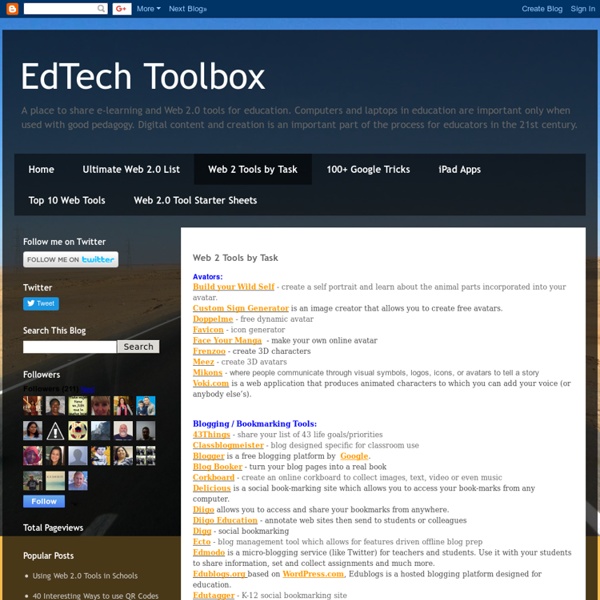The 35 Best Web 2.0 Classroom Tools Chosen By You
If you’re not an avid follower of #edchat on Twitter, you may be missing out on a great opportunity to learn about some new Web 2.0 tools that are currently being used in classrooms around the world. That’s because @chickensaltash posed a simple question to the PLN and there has been a huge swell of support as hundreds of people have jumped in to answer the question about which 5 Web 2.0 tools teachers are using in classrooms. The Best of the Best You can view the live stream of #edchat here and see what people are saying at the hashtag #chickenweb2tools here. We scoured hundreds of responses and have come up with the following list. The following tools have not been verified and are simply based on the number of times each was mentioned on Twitter during this hashtag discussion.
learnexmumbai
How to build your spoken English confidence? - 04 useful tips. Speaking a foreign language can be really intimidating. You know that you're probably making mistakes. You're worried that you might say something offensive and make people angry.
How to Teach Students Coding When You Don't Know How to Code
Digital Technologies has to be one of the most exciting and rapidly changing key learning areas in schools. However, it’s a KLA that makes the digital divide between teachers (whether socio-cultural or generational) even more apparent. While some primary school teachers are completely confident introducing digital technology activities into their classrooms, others have no experience or even fear this ‘new’ learning area. This knowledge divide means that sometimes students can spend a year learning how to code with one teacher and then move onto the next year level with a teacher who doesn’t feel at all comfortable creating opportunities for kids to code during class time. What’s important to realise is that teachers don’t need to know how to code in order to provide their students with the opportunity to do it! I realise this is a somewhat controversial statement.
100 Excellent Art Therapy Exercises for Your Mind, Body, and Soul
January 9th, 2011 Pablo Picasso once said, "Art washes away from the soul the dust of everyday life." It's no surprise, then, that many people around the world use art as a means to deal with stress, trauma and unhappiness – or to just find greater peace and meaning in their lives.
100+ Google Tricks
Posted by Nexus – 01/03/2010 With classes, homework, and projects–not to mention your social life–time is truly at a premium for you, so why not latch onto the wide world that Google has to offer? From super-effective search tricks to Google hacks specifically for education to tricks and tips for using Gmail, Google Docs, and Google Calendar, these tricks will surely save you some precious time. Search Tricks These search tricks can save you time when researching online for your next project or just to find out what time it is across the world, so start using these right away. Convert units.
What British People Say vs. What They Really Mean
British journalist-turned-novelist Lucy Sykes has become known for her snarky social commentary, thanks to her bestseller The Knockoff, a satirical take on the budding fashion tech world. Now, she and co-author Jo Piazza are at it again with their forthcoming novel Fitness Junkie (out July 11), which comically tackles society's wellness obsession. Given Sykes' British background—and her penchant for keeping it real—we asked her and her sister, author Plum Sykes, to give us a breakdown of popular British phrases, and what they really mean. 1 'You look amazing.' = Is that dress a good idea? Advertisement - Continue Reading Below 2 'Another cup of tea?'
How to Set Up Your Makerspace
What does a makerspace look like, exactly, and what kind of tools and materials will you need? The consensus reached by the maker educators and makerspace designer we talked to was that, well, there shouldn't be any consensus. Makerspaces, just like making itself, should be adaptable to the needs of each school. Part 1: Where to Start
How to Use the Board Effectively in ELT
In this article and accompanying video, I will talk about using the board effectively in ELT (English language teaching). The board is perhaps the most useful piece of equipment in the language classroom. Note that this post is written mainly for teachers using whiteboards (not digital interactive boards), although a lot of the advice still applies. Watch the video here:
Engaging Students Through Gamification
In 2015, teacher-librarian Tasha Squires of O’Neill Middle School in Downers Grove, Illinois, entered the Follett Challenge, an annual contest from Follett School Solutions that showcases schools with innovative methods for learning 21st-century skills. O’Neill Middle School won the grand prize—$60,000—and has used the funding to enhance its reading and writing program. Here, Squires explains how it all came about. Every day, educators look for ways to engage students and help them develop 21st-century skills necessary to function in our world.
ELLLO Views #1462 Nepal Travel Tips
Adam: Alright, hi Jin! Jin: Hi, Adam. Adam: How are you doing? Jin: I'm doing good. Adam: Ah, you're from Nepal right? Jin: Yes, I am.
75-100-irregular-Verbs
<div class="noscript-warning"> JavaScript is currently disabled in your browser. You must have JavaScript enabled to take full advantage of Box.</div> No actions available


